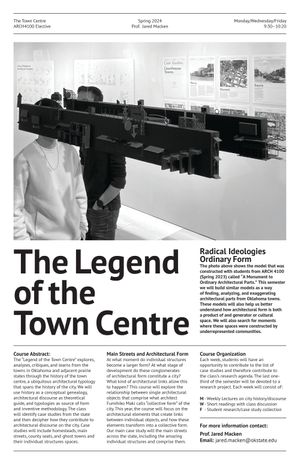Radical Ideologies, Ordinary Form
The photo above shows the model that was constructed with students from ARCH 4100 (Spring 2023) called “A Monument to Ordinary Architectural Parts.” This semester we will build similar models as a way of finding, analyzing, and exaggerating architectural parts from Oklahoma towns. These models will also help us better understand how architectural form is both a product of and generator or cultural space. We will also search for moments where these spaces were constructed by underrepresented communities.
Course Abstract:
The “Legend of the Town Centre” explores, analyzes, critiques, and learns from the towns in Oklahoma and adjacent prairie states through the history of the town centre, a ubiquitous architectural typology that spans the history of the city. We will use history as a conceptual genealogy, architectural discourse as theoretical guide, and typologies as source of form and inventive methodology. The class will identify case studies from the state and then decipher how they contribute to architectural discourse on the city. Case studies will include homesteads, main streets, county seats, and ghost towns and their individual structures spaces.
Main Streets and Architectural Form
At what moment do individual structures become a larger form? At what stage of development do these conglomerates of architectural form constitute a city? What kind of architectural links allow this to happen? This course will explore the relationship between single architectural objects that comprise what architect Fumihiko Maki calls “collective form” of the city. This year, the course will focus on the architectural elements that create links between individual objects, and how these elements transform into a collective form. Our main case study will the main streets across the state, including the amazing individual structures and comprise them.

